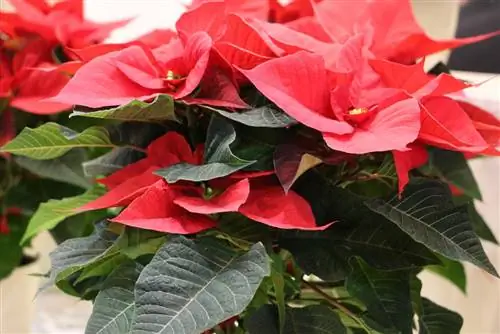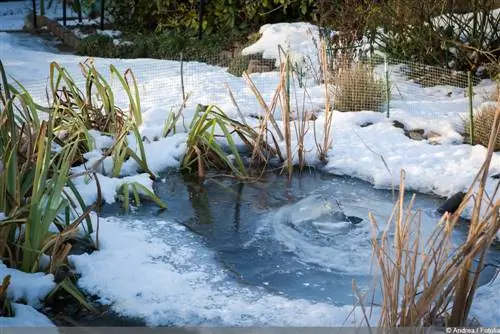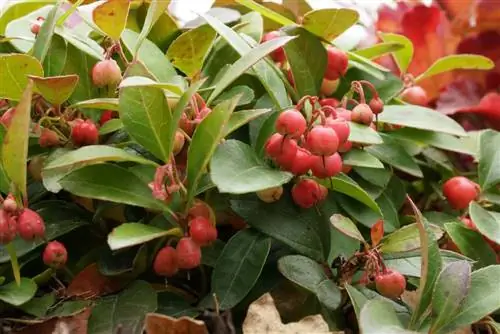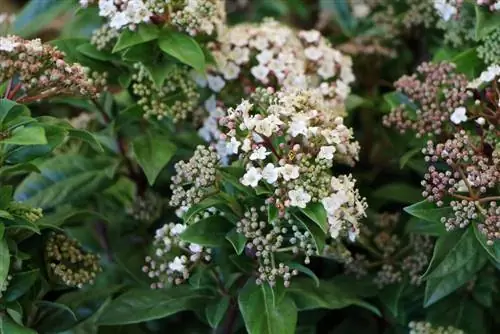- Author admin [email protected].
- Public 2023-12-17 03:39.
- Last modified 2025-06-01 06:48.
During the winter months, most plants have stopped growing. To bring a little play of color into your home garden during the cold season, winter bloomers are ideal - trees, shrubs and perennials that bloom in the darker months thrive magnificently with a little care. Many species of winter bloomers can also be kept as potted plants on balconies.
Popular winter bloomers with particularly beautiful flowers
- Helleborus niger - Christmas rose
- Helleboris orientalis - Lenten rose
- Adonis amurensis - Adonis floret
- Hamamelis mollis - witch hazel
- Jasminum nudiflorum - winter jasmine
- Virburnum opulus - Snowball
- Lonicera purpusii - scented honeysuckle
Christmas rose - Helleborus niger
The Christmas rose, also known as the snow rose or Christmas rose, belongs to the buttercup family (Ranunculaceae). All parts of this plant are poisonous. Helleborus niger has white flowers.
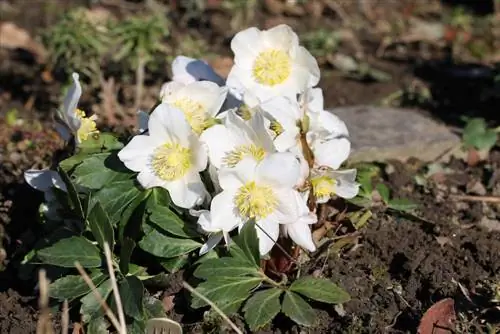
Location
Christmas roses bloom in the cold winter months, but prefer a sheltered location. A place under a tree that provides plenty of shade in summer is ideal for the Christmas rose. In winter, the Christmas rose needs a lot of light, but full sun should be avoided. Helleborus niger needs a permeable, calcareous soil structure. The plant grows particularly vigorously if a little clay and compost are added to the soil. A layer of mulch, for example made from fallen autumn leaves, is also advisable.
Care
In order to preserve a Christmas rose for as long as possible, you should refrain from changing its location regularly. Helleborus niger thrives best when it stays in the same place for years. Christmas roses react sensitively to too much moisture. They should therefore be watered sparingly. However, the earth must under no circumstances be allowed to dry out completely.
Fertilizer
Compost and horn meal are suitable as fertilizers for the Christmas rose. Non-organic fertilizer must be used very sparingly. Fertilization is carried out at the beginning of flowering and again in mid-August. Helleborus niger grows to around 30 centimeters tall and does not require regular cutting. However, wilted leaves and shoots can be easily removed.
Adonis florets - Adonis amurensis
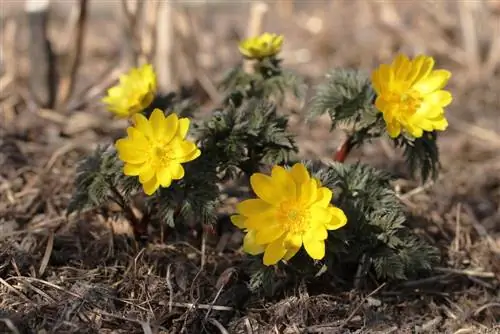
Like the Christmas rose, the Adonis rose belongs to the buttercup family. The plant is very robust and insensitive to frost in our latitudes. Like Helleborus niger, the plant is highly poisonous. The Adonis rose blooms in bright yellow.
Location
The Adonis rose is suitable for planting in perennial beds as well as for planting in the rock garden. The plant with small, golden yellow flowers prefers sunny to semi-shady places. Adonis amurensis needs a certain amount of time to get used to a new location, but after this it thrives well. The soil should have a well-drained structure for the Adonis rose. In addition, a pH value of the soil of neutral to slightly alkaline is ideal. If possible, the Adonis rose should not be placed near vigorous plants, otherwise there is a risk that it will be displaced.
Care
Adonis amurensis is a little sensitive to waterlogging. Complete drying out of the soil should also be avoided. Regular, sparingly distributed watering allows the plant to thrive. Adonis florets are susceptible to snail infestation.
Magic hazel - Hamamelis mollis
Hamamelis mollis comes from Asia and belongs to the witch hazel family (Hamamelidaceae). In contrast to those of other witch hazel species, their flowers are larger and more lush.
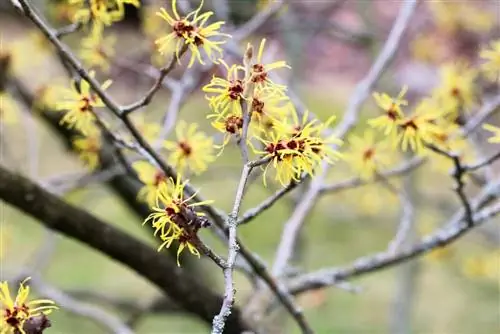
Location
The witch hazel requires loose, humus-rich soil. This should be permeable, but never completely dry out. Root competition from other trees is extremely harmful to Hamamelis mollis. The ideal location for witch hazel is sunny and protects it from easterly winds. A place on a wall or house wall is therefore a good idea.
Care
The witch hazel should be supplied with nutrients, especially in spring. A layer of bark mulch is also recommended. Pruning is usually not necessary for Hamamelis mollis. If cared for well, the plant forms a beautiful and evenly grown crown. Cut wounds on witch hazel also heal very poorly. Hamamelis mollis is also sensitive to transplants. The emergence of the flowers may be delayed by several weeks in some years.
Winter jasmine - Jasminum nudiflorum
Jasminum nudiflorum belongs to the olive family (Oleaceae). Its yellowish flowers are particularly striking. Winter jasmine is often called winter broom because of its similarity to gorse.

Location
Jasminum nudiflorum should be planted in a sunny to partially shaded location. It prefers a well-drained, neutral to alkaline soil. The plant must be protected from strong easterly winds. Winter jasmine can also be used as a container plant. If the plant is used as a climbing plant, a scaffold is necessary. A wall, a railing or other shrubs can be useful here.
Care
Jasminum nudiflorum needs to be fertilized in spring. In extreme drought, extensive watering is necessary. Older bushes can be rejuvenated regularly by pruning every few years. Pruning always takes place after the flowering period. In order to stimulate the growth of winter jasmine, the shoots are slightly trimmed in the summer months.
Winter bloomers can be used to add great color accents to gardens and balconies during the barren season. A large selection of shrubs, trees and perennials with colorful flowers are available. With adequate care, the plants thrive and last for years.
What you should know about winter bloomers soon
Unfortunately, only a few of our potted plants bloom in winter. If you want to add some color to your home in winter, you don't have much choice. Well-known winter bloomers in the house are the popular cyclamen, which bloom especially in winter and into spring.
- The poinsettias with their blooming season are also a popular splash of color in the cold season. The gardeners have refined and further developed the winter bloomers in the house.
- They are no longer only available in red. Poinsettias are offered in different color variations, as are cyclamens. And these winter bloomers in the house have also been further developed in terms of their care. They are no longer so sensitive and demanding, but have become much easier to care for.
- Another way to get winter bloomers in the house is to grow flowers from tubers and bulbs. A well-known example here is the hyacinth, which creates a color accent on the windowsill and gives an idea of spring.
- In late winter you can also put out a bowl of crocuses or pansies and enjoy their colors. Snowdrops also belong to this group, but are less common as winter bloomers in the house.
So they exist, the winter bloomers in the house. You don't have to survive the winter without flowering plants on your windowsill. The nurseries also offer many different flowers that bloom and delight us all year round. And when spring comes and the first winter bloomers and early bloomers can be seen outside, then there is really plenty on offer.

